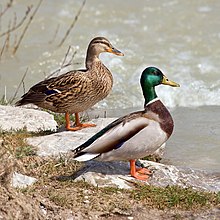Duck
The Picture above is a Mallard Duck(Anas platyrhynchos)
Scientific Classification
Kingdom: Animalia
Phylum: Chordata
Class: Aves
Order: Anseriformes
Superfamily: Anatoidea
Family: Anatidae
The word duck comes from Old English duce "diver" , a derivative of the verb ducan "to duck, bend down low as if to get under something, or dive", because of the way many species in the dabbling duck group feed by upending; compare with Dutch duiken and German tauchen "to dive".
A male duck is called a drake and the female is called a duck, or in ornithology a hen.
So If you named your plane Drake because it sounds like a breed of a dragon well you just named your plane a male Duck.
Morphology
The overall body plan of ducks is elongated and broad, and the ducks are also relatively long-necked, albeit not as long-necked as the geese and swans. The body shape of diving ducks varies somewhat from this in being more rounded.
Mallard Duck

Female (left) and male (right)
To be Honest this duck is very Interesting to me because the Drake(male Mallard) have a glossy green head
and grey on their wings and belly,
While the Female have mainly brown-speckled plumage.
So it is easy to recognise which one is a male and a female.
Conservation status
The mallard is considered to be a species of least concern by the International Union for Conservation of Nature (IUCN). Unlike many waterfowl, mallards are considered an invasive species in some regions. It is a very adaptable species, being able to live and even thrive in urban areas which may have supported more localised, sensitive species of waterfowl before development. The non-migratory mallard interbreeds with indigenous wild ducks of closely related species through genetic pollution by producing fertile offspring. Complete hybridisation of various species of wild duck gene pools could result in the extinction of many indigenous waterfowl. The wild mallard is the ancestor of most domestic ducks, and its naturally evolved wild gene pool gets genetically polluted by the domesticated and feral mallard populations.
Description

Mallard Duckling
The mallard is a medium-sized waterfowl species that is often slightly heavier than most other dabbling ducks. It is 50–65 cm (20–26 in) long – of which the body makes up around two-thirds – has a wingspan of 81–98 cm (32–39 in),:505 and weighs 0.72–1.58 kg (1.6–3.5 lb).Among standard measurements, the wing chord is 25.7 to 30.6 cm (10.1 to 12.0 in), the bill is 4.4 to 6.1 cm (1.7 to 2.4 in), and the tarsus is 4.1 to 4.8 cm (1.6 to 1.9 in).
The breeding male mallard is unmistakable, with a glossy bottle-green head and a white collar that demarcates the head from the purple-tinged brown breast, grey-brown wings, and a pale grey belly.The rear of the male is black, with white-bordered dark tail feathers.:506 The bill of the male is a yellowish-orange tipped with black, with that of the female generally darker and ranging from black to mottled orange and brown.The female mallard is predominantly mottled, with each individual feather showing sharp contrast from buff to very dark brown, a coloration shared by most female dabbling ducks, and has buff cheeks, eyebrow, throat, and neck, with a darker crown and eye-stripe.
Known Phobia caused by Ducks
Anatidaephobia is defined as a pervasive, irrational fear that one is being watched by a duck. The anatidaephobic individual fears that no matter where they are or what they are doing, a duck watches.
Anatidaephobia is derived from the Greek word "anatidae", meaning ducks, geese or swans and "phobos" meaning fear.
Random guy :dude, Anatidaephobia is the coolest phobia ever!
Notaleopard :quack!
Cure
There are several methods of treatment that are used to help patients overcome anatidaephobia. One such treatment method is called NLP, or Neuro-Linguistic Programming, which is a type of cognitive behavioral therapy. Cognitive behavioral therapy works by attacking our "learned or programmed" thoughts to re-program the brain to reverse what the patient has "learned" and eliminate his or her fear.
Self-help therapeutic methods can also be effective. Here, therapists teach their patients techniques that connect their bodies to their minds, such as deep breathing, meditation, and journaling their positive thoughts. Journaling can help them rationalize their negative thoughts and finally overcome their fear.
In extreme cases, medication may be prescribed to help the patient cope with the symptoms that result from his or her phobia. Medication is considered a last resort, as it does not attack the root of the fear; it only makes the symptoms easier to cope with. By eliminating the fear, the symptoms should naturally subside. However, if treatment is expected to be lengthy, a psychiatrist may prescribe medication to help the patient feel better in the meantime while they continue to attack and try to eliminate the true cause of his anxiety.

@Bman01 I hope your joking
See ducks don’t float, their legs are actually long enough to touch a riverbed
Shhhh
"Belugasub is listening*
Ducc>everything @ChiyomiAnzai
Here, we have four clips of the sacred duccs in their natural habitat:
DUCC
DUCC
DUCC
DUCC
quality duccpost
“Brief duck (ducc) info”
You disgrace the ducc by your abhorrent misspelling of our great and holy name.
And almost every Noble people love hunting them with a 12 gauge rifle. 😂
In french we call them "canard Colvert",(Col-vert, green neck) because of the color of the male's head.
It’s my species!